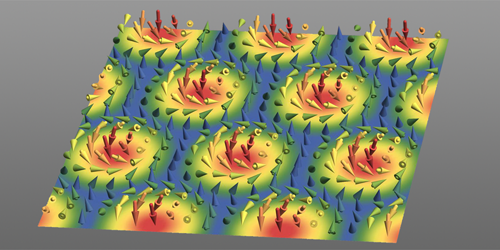How to Clean Up a Skyrmion Lattice
A magnetic skyrmion is a localized pattern of atomic spins, such as a vortex, and it can move through a material while the atoms stay in place, like a loose knot moving along a string. A 2D array of such objects—a skyrmion lattice—could be the basis for a future magnetic memory, but researchers are still learning how to manipulate such arrays. Now Daisuke Okuyama of Tohoku University in Japan and his colleagues have found some surprises when observing the response of a skyrmion lattice to an oscillating electric current [1]. At low frequencies, the lattice oscillates as a unit, but above about 0.1 Hz, each skyrmion oscillates independently. This random jostling “cleans up” the lattice, removing many discontinuities (dislocations)—a process that could be beneficial for future devices.
Understanding how skyrmions move will be key to using them in ultrahigh-density memories, but there have been few experiments exploring skyrmion motion, Okuyama says. He and his colleagues previously applied a direct current to a skyrmion lattice in manganese monosilicide and observed the lattice motion using a neutron beam [2]. They found that the lattice moves but becomes strongly distorted at the edges of the material where the lattice is pinned in place.
Their new experiments, using an alternating current, show that this pinning and distortion occur only at frequencies below a threshold value (0.1 Hz). At higher frequencies, the distortion disappears, as do many of the dislocations and boundaries between lattice regions having perfect order, thanks to the random and independent jiggling of the skyrmions. Okuyama says that the simplest theoretical models can’t account for this frequency-dependent behavior, so new ones will need to be developed.
–David Ehrenstein
David Ehrenstein is a Senior Editor for Physics Magazine.
References
- D. Okuyama et al., “Detailed dynamics of a moving magnetic skyrmion lattice in MnSi observed using small-angle neutron scattering under an alternating electric current flow,” Phys. Rev. B 110, 014431 (2024).
- D. Okuyama et al., “Deformation of the moving magnetic skyrmion lattice in MnSi under electric current flow,” Commun. Phys. 2, 79 (2019).




